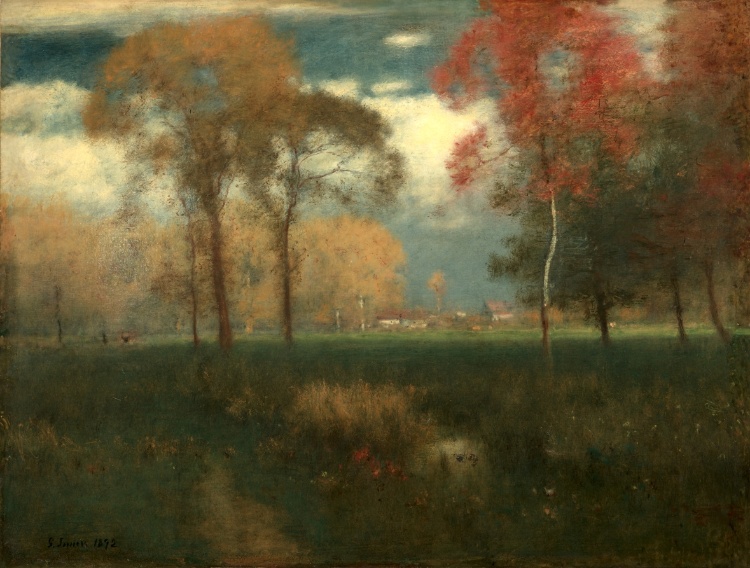 George Inness, Sunny Autumn Day, 1892, oil on canvas, 31 7/8” x 41 11/16”, Cleveland Museum of Art, Photo by pirano Bob R via Fickr, Creative Commons Attribution-NonCommercial-NoDerivs 2.0 Generic License.
George Inness, Sunny Autumn Day, 1892, oil on canvas, 31 7/8” x 41 11/16”, Cleveland Museum of Art, Photo by pirano Bob R via Fickr, Creative Commons Attribution-NonCommercial-NoDerivs 2.0 Generic License.
George Inness, the American landscape painter, was at different points in his career associated with the American Hudson River School and the French Barbizon School of landscape painting; yet, it’s the work he did at the end of his career – the paintings that inspired the Tonalist movement – that arguably is his most powerful.
The paintings that Innes created between the years 1885 and his death in 1894, when he lived in Montclair, New Jersey, represent his signature style that he developed to present the spirituality that the artist believed was in the natural world. Inness, who was a follower of the theology of Emanuel Swedenborg, believed that everything in nature had a mystical component, which he conveyed in his paintings with asymmetrical and balanced compositions, forms with softened edges, saturated color and a clear distinction between the sky and earth.
 George Inness, Sunny Autumn Day, 1892, oil on canvas, 31 7/8” x 41 11/16”, Cleveland Museum of Art, Photo by pirano Bob R via Fickr, Creative Commons Attribution-NonCommercial-NoDerivs 2.0 Generic License.
George Inness, Sunny Autumn Day, 1892, oil on canvas, 31 7/8” x 41 11/16”, Cleveland Museum of Art, Photo by pirano Bob R via Fickr, Creative Commons Attribution-NonCommercial-NoDerivs 2.0 Generic License.
 George Inness, Sunny Autumn Day, 1892, oil on canvas, 31 7/8” x 41 11/16”, Cleveland Museum of Art, Photo by pirano Bob R via Fickr, Creative Commons Attribution-NonCommercial-NoDerivs 2.0 Generic License.
George Inness, Sunny Autumn Day, 1892, oil on canvas, 31 7/8” x 41 11/16”, Cleveland Museum of Art, Photo by pirano Bob R via Fickr, Creative Commons Attribution-NonCommercial-NoDerivs 2.0 Generic License.
